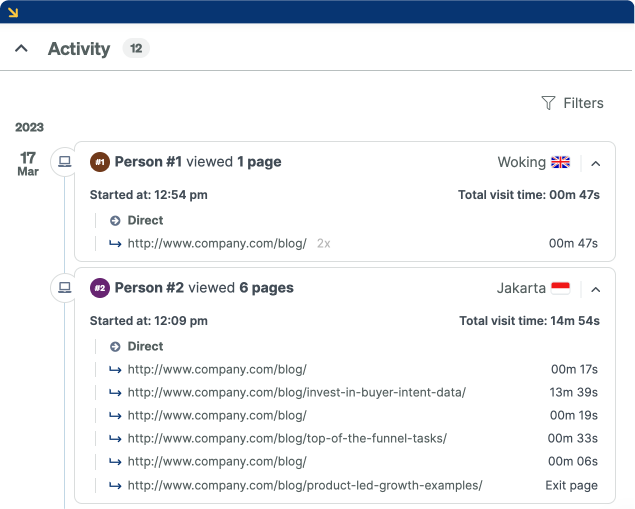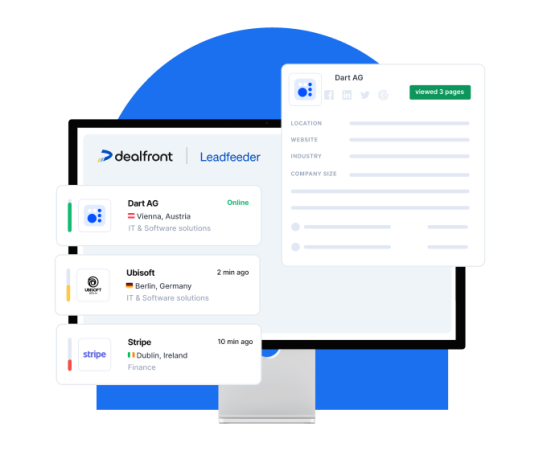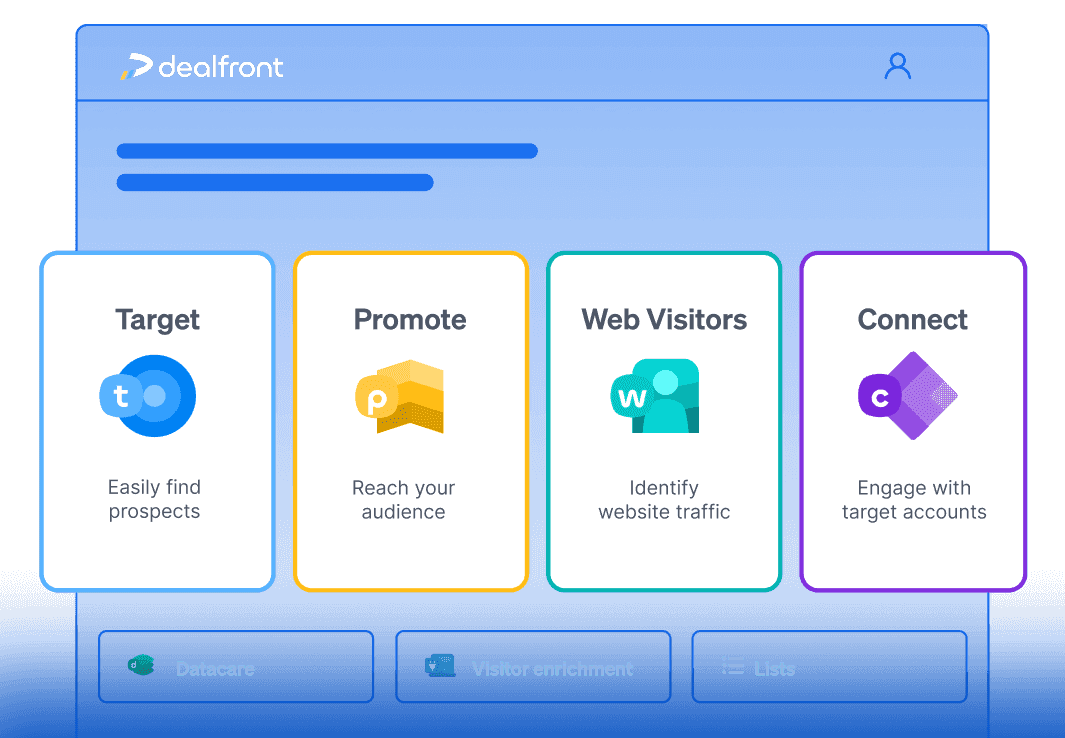Lead scoring is like a traffic light, signaling how quickly you should move forward with your leads. It signals when to go full speed ahead, when to slow down, and when to stop.
Lead scoring is essentially the process of evaluating and ranking potential leads based on their readiness to make a purchase. We’ll be talking about:
The importance of lead scoring in B2B
The differences between interest-based and intent-based scoring
The benefits and limitations of each approach
How to combine interest- and intent-based scoring effectively
Best practices for lead-scoring success
Common mistakes to avoid
What is lead scoring?
Lead scoring is a key part of modern B2B marketing and sales strategies. It involves assigning a numerical value, or score, to each lead. This score reflects the lead’s engagement level, interest, and potential as a customer.
But why is lead scoring so essential? In the world of B2B, businesses target other businesses as clients. And not all leads are created equal.
Lead scoring helps distinguish between prospects ready to convert and those who may need more nurturing. It increases the effectiveness of your sales efforts in the following ways:
Resource allocation: Lead scoring lets you focus your efforts where they matter most. High-scoring leads receive immediate follow-up from sales. Low-scoring leads get more nurturing from marketing. This ensures your sales reps use their time effectively.
Enhanced personalization: Accurate lead scoring helps customize how you communicate with leads. You can tailor your marketing messages and sales follow-ups to address a lead’s specific needs and pain points. This personalization increases the chances of conversion. Case in point, about 80% of customers are likelier to buy from a company that personalizes their communications.
Shorter sales cycles: Lead scoring helps you find the best leads who are closer to buying. This speeds up the selling process and shortens your sales cycle.
Improved collaboration: Marketing and sales teams often work in silos. Lead scoring bridges this gap. It provides a common framework for identifying high-quality leads. As a result, you can ensure smoother handoffs between teams and a more cohesive approach to customer acquisition.
Data-driven decision-making: Lead scoring relies on data and analytics. Analyzing lead behavior and engagement gives you valuable insights into what works and what doesn't in your sales and marketing efforts. This data-driven approach empowers continuous improvement and optimization.
Now that we’re familiar with lead scoring and why it’s important, let’s look at the two main types of lead scoring.
Interest-based lead scoring
What is interest-based lead scoring?
Interest-based scoring assigns scores to leads based on their level of engagement and interest in a company's products or services.
With this method, sales software assigns leads scores based on their actions. These can include website visits, content downloads, email opens, webinar attendance, and more. The key premise is that engaged and interested leads are more likely to convert.
What indicates interest?
Interest-based lead scoring gives different weight to various customer actions. It does so based on the actions' significance in the buyer's journey.
For instance, a lead who consistently engages with high-value website content like technical white papers will receive a high score. Conversely, someone who visits your website from time to time will receive a low score.
Beyond technical white papers and website visits, other factors that show interest include:
Email open rates
Email click-throughs
Webinar attendance rates
Survey responses
A long duration of website sessions
Interest-based lead scoring benefits and limitations
Among the top benefits of interest-based scoring are:
Personalized outreach. With a granular understanding of leads' interests, you can tailor your emails and texts to resonate with their specific needs. Personalization enhances engagement and builds trust.
Optimized content strategy. Interest-based scoring reveals which blog content assets are most effective at driving conversions. This insight enables you to refine your content strategy. It allows you to create more of what resonates with your target audience.
Shorter sales cycle. Identifying leads with a high degree of interest allows you to move them through the sales cycle quickly. This shortens the sales cycles for faster revenue growth.
Improved decision-making. Continuous tracking of interest-based scores provides valuable data points. It allows for refining lead-scoring models and marketing strategies over time.
That said, there are some limitations to interest-based scoring, including:
Limited insights into offline interactions
Interest-based lead scoring mostly looks at online behavior. It might miss important things leads do in person or outside the internet. For instance, a potential customer may attend an industry conference and engage in a meaningful conversation at the company's booth. Interest-based scoring might not capture this offline interaction. This example shows the importance of considering a lead's online and offline engagement.
Dependence on accurate data
Interest-based scoring requires accurate and up-to-date data to function. Inaccuracies can lead to misjudging a lead's level of interest. For example, many email providers pre-load email images. Email marketing software may register this pre-load as an open rate. But the lead didn't actually open the email. This inaccurate data could make a salesperson think the lead is more interested than they are. It could result in premature and ineffective outreach efforts.
Intent-based lead scoring
Intent-based scoring goes a step further than interest-based scoring. Let's look at how.
What is intent-based lead scoring?
Intent-based scoring looks for actions showing someone is super close to buying a product or service. The leads may be checking prices or asking for a product demo repeatedly.
The focus here is on the buyer's intent. Meanwhile, interest-based scoring examines customers' interest or general curiosity about products and services.
What factors indicate intent?
A high-intent lead is one who performs the following actions repeatedly:
Visits pricing pages
Downloads product data sheets
Requests a product demo and pricing tiers
Incorporating purchase intent into your lead-scoring techniques helps you rank leads more effectively. The lead-scoring software can route high-intent leads to sales teams for immediate attention. This will increase the short-term likelihood of conversion.
In the same way, the software can send low-intent leads to the marketing team. Marketers can nurture these leads with emails and other targeted content until they get stronger buying signals.
Intent-based lead scoring benefits and limitations
Intent-based scoring shares upsides with interest-based scoring. These include shorter sales cycles, individualized outreach, and efficient use of resources. All contribute to better business outcomes.
However, there are some downsides to intent-based scoring, including:
Complexity
Implementing intent-based scoring can be complex and resource-intensive. Intent can change quickly. Some leads may exhibit high buying intent one moment and low intent the next. Real-time tracking and advanced analytics tools are crucial.
Inability to measure long-term potential
Interest-based scoring may not account for a lead's customer lifetime value (CLV). CLV stands for the total revenue a business can expect to earn from a customer throughout their relationship. For instance, someone who comes to your website by searching "best email marketing software for 2023" on Google shows strong short-term buying intent.
But they may not stay around for long. A business owner who attends several webinars without buying may get a "low-priority" ranking. But they may stay with you longer, as they show long-term intent. It's still worth nurturing the second lead, even if closing them might take longer.
Intent-based lead scoring offers several advantages in optimizing lead management. But you should combine it with other scoring methods to achieve the best results.
Interest vs. Intent: How are they different?
Interest-based lead scoring is about general interest in a product or service. Businesses can measure it by tracking various user actions. These can be opening emails, visiting a website, downloading resources, or attending webinars. The scoring model assigns points based on the frequency and depth of interactions.
Intent-based lead scoring, however, tracks whether leads actually want to buy soon. It measures behaviors that signal buying intent. These include consuming content about product features, requesting demos, and visiting pricing pages.
Using a tool like Leadfeeder by Dealfront can set you up with amazing insights to do just that!

The difference lies in the depth of prospect engagement and their position in the buying journey. Interest-based scoring captures a broader range of prospects who may still be in the early stages of research. Intent-based scoring hones in on those further along in the decision-making process.
As shown, the two lead-scoring techniques can assign lower or higher scores to leads. It all depends on their position in the marketing or sales funnel. Businesses can use the results to tailor their marketing messaging, as in the examples below:
Send weekly emails to high-interest leads with content related to the lead's general interests and needs.
Display retargeting ads to high-intent leads who visited specific product or pricing pages. The ads could remind leads of product offerings and encourage them to return and buy the item.
Businesses can also improve their selling strategies using these methods:
Follow up with monthly phone calls to answer questions and nurture interest. High-interest leads will appreciate informative discussions.
Arrange a one-on-one product demo or a meeting with a sales representative to discuss contract terms. High-intent leads who are more ready to buy need more direct engagement.
Effective lead-scoring tools
Effective lead scoring is beneficial but can be complex. Consider using tools specifically built to help businesses capture buyer interest and intent. The top ones include HubSpot, Marketo, Pardot by Salesforce, and Leadfeeder by Dealfront.
Hubspot, Marketo, and Pardot offer similar features. They capture lead interest and intent through lead tracking, email opens, website engagement, and form submissions. Leadfeeder by Dealfront also helps with these areas but goes a step further by:
Identifying traffic: Leadfeeder identifies the companies visiting your website. It has the highest company recognition rate on the market.
Leveraging intent data: Leadfeeder has 50+ behavioral and firmographic filters. It qualifies companies based on their firmographic and demographic data. This includes information like industry, location, company size, and corporate structure (LLC vs. public corporation vs. private corporation). With this data, your software can weed out leads who don’t meet your ideal customer profile.
Acquiring contact info: Knowing a company visits your website is one thing. But how do you find and contact its decision-makers? Leadfeeder has a contact database for filtering decision-makers. You can do so based on job title, seniority, and location. Leadfeeder has emails, phone numbers, and LinkedIn profiles. Sales teams can use all this info to contact leads who meet their ideal customer profile.
Syncing with CRMs: Leadfeeder has native, two-way integration with all major CRM and marketing automation tools. There’s no need to change solutions or processes.
Which one of these tools will be best for your organization depends on your needs. To make an informed choice about lead-scoring software, define your goals. Do you need to identify anonymous traffic? Do you need a tool that works with your existing CRM, or do you want to change a CRM? Do you sell to large corporations with long procurement processes and multiple decision-makers?
Remember to try out free trials or demos. It will let you estimate how well the chosen tool aligns with your unique business requirements.
Armed with the best tool for your business, you’ll want to use best practices for successful lead scoring. Let’s explore some of those now.
Best practices for successful lead scoring
Once you have the right tools, you can start developing a strategy for successful lead scoring. Follow the below practices for the best results:
Combining lead scoring systems
Combine interest and intent-based lead scoring for ultimate sales results. Optimize your lead management process by:
Creating a dual-scoring system
Businesses can assign separate scores for interest and intent-related activities. This creates a dual-scoring process.
The benefits of a dual-scoring system are various. But the biggest one is a comprehensive view of each lead's behavior. Such a system considers the leads' general curiosity and their readiness to buy.
The lead-scoring software can identify prospects showing strong interest. It can do so through engagement metrics like email opens and content downloads. Conversely, the software can pinpoint new leads who show sales-ready behavior. It can do so by tracking data such as repeated visits to product pages.
Implementing dynamic lead nurturing sequences
With the dual scoring system findings, businesses can create lead nurturing sequences. These can adapt to a lead's score and help you tailor your offering.
Leads with high interest but lower intent scores may enjoy educational content. Leads with high buy intent scores may like more direct and sales-oriented communication. You could capitalize on their readiness to engage with sales teams.
This tailored approach ensures that leads receive the right level of engagement at the right time. It thereby works to boost the conversion rates.
Common mistakes and how to avoid them
B2B businesses often make these mistakes when it comes to lead scoring in the B2B sales process:
Failing to establish and document clear scoring criteria. Sales and marketing teams need well-defined criteria. Otherwise, there might be confusion about how to score specific actions or behaviors. This can lead to inefficient lead management, missed opportunities, and disagreements between teams.
Overlooking the importance of data quality and consistency. Inaccurate or incomplete data points can lead to incorrect lead scores. It can cause misjudgments about a lead's readiness to buy. That's why companies should regularly check and keep their data accurate. Only that way they can base lead scoring on trustworthy information.
Applying a one-size-fits-all lead scoring model to leads. This methodology doesn't consider the different ways leads interact with the business. As such, it can lead to missed opportunities. Tailor lead scoring models to specific customer personas or industry segments. This will yield more accurate results and better alignment with individual lead journeys.
Avoiding these mistakes requires careful planning and monitoring. It also requires shifting the lead-scoring strategies to match changes in prospect behavior. But with a solid strategy in place, companies can secure considerable B2B success.
Mastering lead scoring for B2B success
B2B businesses looking to optimize their marketing and sales efforts need a balanced strategy in place. A big part of securing this balance lies in aligning modern lead-scoring methods.
Interest- and intent-based scoring models offer the best way to convert qualified leads in modern times. The first one identifies general interest in new leads. The second one spots strong buying intent. Combined, they give clear direction to sales and marketing teams.
Consider using third-party tools to install these two methods into your lead-scoring strategy. Solutions like Leadfeeder by Dealfront can help you capture and analyze lead behavior. They can also provide actionable insights for effective prospecting.
But once you put in place a lead-scoring strategy, don't forget to maintain and readjust it. Customer trends and behaviors change over time. You should customize your data and scoring models according to these changes. Utilizing advanced sales automation software can streamline this process. Only by refining your strategies, can you achieve top sales and marketing performance.







